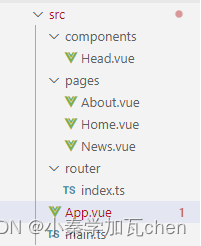1、引用路由组件
npm install vue-router2、创建路由
根据项目结构创建对应的组件(home\news\about)

在 src 目录下创建 router/index.ts
//引入路由
import { createRouter,createWebHistory,createWebHashHistory } from 'vue-router'
import Home from '@/pages/Home.vue'
import News from '@/pages/News.vue'
import About from '@/pages/About.vue'//创建路由器
const router = createRouter({history:createWebHistory(),routes:[{path:'/',name:'home',component:Home},{path:'/news',name:'news',component:News},{path:'/about',name:'about',component:About}]
})
//导出
export default routerhistory的两种区别:
1、createWebHistory 浏览器窗口不会显示 # ,但是项目部署到服务器,使用刷新按钮时会出错。
解决:在 nginx.conf 里添加:try_files $uri $uri/ /index.html;
location / {root /usr/share/nginx/html;try_files $uri $uri/ /index.html;index index.html index.htm;}2、createWebHashHistory 浏览器会显示 # ,不美观,但不会出错
3、引入路由
我们要将路由使用到项目中,需要到 main.ts 中导入
import {createApp} from 'vue'
import App from './App.vue'
//router目录下只有一个index.ts 则可以省略不写
import router from './router'//创建一个应用
const app = createApp(App)
//使用路由器
app.use(router)
//挂在整个应用
app.mount('#app')4、使用路由
在vue文件中使用路由
<template><div class="App"><Head/><!--导航区--><div class="navigate"><RouterLink to="/" active-class="router-link-active">首页</RouterLink><RouterLink :to="{path:'/news'}">新闻</RouterLink><RouterLink :to="{name:'about'}">关于</RouterLink></div><div class="main-content"><RouterView></RouterView></div></div>
</template><script lang="ts" setup name="App">import {RouterView,RouterLink} from 'vue-router'import Head from '@/components/Head.vue'
</script><style>
a{list-style: none;margin-right: 10px;text-decoration: none;color:gray;
}
.main-content{width:500px;height:300px;border:1px solid grey;margin-top: 20px;
}
.router-link-active{color:blueviolet;font-weight: bold;
}
</style>
RouterLink 路由绑定的两种写法:
1、to="/" 静态绑定
2、:to = "{path:'/home'}" 绑定对象,更加灵活
效果:

)


















